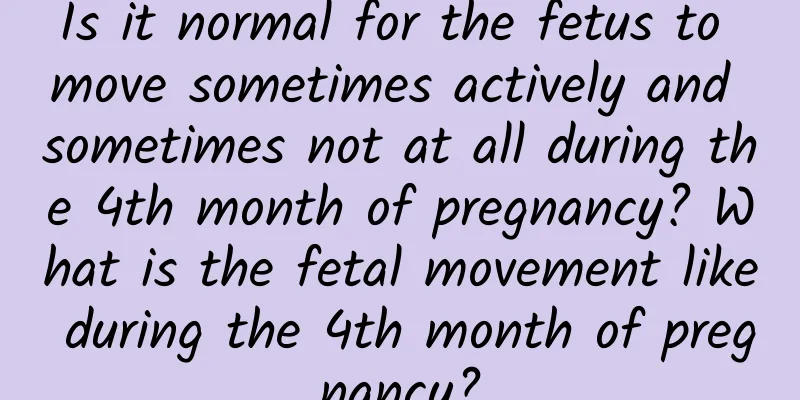Can you see the gestational sac at 38 days of pregnancy?

|
For every expectant mother, the baby in her arms is of course very important. One thing that humans have been persisting in from ancient times to the present is reproduction. Therefore, many women will be gossiped about in this society if they cannot have children. And women are born to love children. So, can you see the fetal sac at 38 days of pregnancy? How much is the fetal sac at 38 days of pregnancy Generally speaking, the gestational sac can be seen by vaginal ultrasound at the first 5 weeks of pregnancy, and a little later by abdominal ultrasound. Because everyone's menstrual cycle is different, the time of pregnancy also varies in the short term. Therefore, the time when the gestational sac can be first seen under B-ultrasound is also different. For women with normal menstrual cycles, ultrasound can usually be performed about 42 days after menstruation to detect whether there is a gestational sac in the uterine cavity. Theoretically, the gestational sac can be seen on the 35th day, but there are large individual differences, and the gestational sac can be seen on the 30th day in some cases. Generally, the gestational sac can be seen after 5 weeks of pregnancy. However, for some women with longer menstrual cycles, late ovulation and late implantation, it may not be visible at this time. Most people recommend doing an ultrasound after 6 or 7 weeks of pregnancy. At this time, not only can you see the gestational sac, but you can also see whether there is a fetal bud, fetal heartbeat and fetal heartbeat. It is recommended not to go for a check-up so early. Since you are pregnant, you should protect the baby well and go for a check-up after three months. It is not good to do a check-up too early. 4 weeks: The fetus is only 0.2 cm. The amniotic cavity is formed just after the sperm and egg combine and the embryo implants, and its volume is not large. Ultrasound cannot clearly show signs of pregnancy. 5 weeks: The fetus grows to 0.4 cm and enters the test tube embryo stage. The amniotic cavity expands, initial cardiovascular and cerebrovascular diseases appear, and heart beats may be present. B-ultrasound can show a small gestational sac, which occupies less than 1/4 of the uterine cavity, or the embryonic bud and fetal heartbeat can be seen from it. 6 weeks: The fetus grows to 0.85 cm. The head, brain alveoli, frontal organs, respiratory, digestive, and nervous organs of the fetus are divided. The gestational sac is clearly visible on B-ultrasound, and the fetal bud, fetal heart rate, and fetal heart rate are also seen. 7 weeks: The fetus grows to 1.33 cm. The test tube embryo has a human prototype, the body segments have all divided, the limbs have separated, and the various systems have further developed. B-ultrasound clearly shows the embryo, fetal heart rate and fetal heart rate. The gestational sac occupies about 1/3 of the uterine cavity. Common problems in early pregnancy In the early stages of pregnancy, the diet of pregnant women may change, also known as mouth ulcer. At this time, you should eat some light-tasting, easy-to-digest foods. Eat more vitamin-rich vegetables and fruits and less greasy food. Remember to drink water or milk when you wake up every morning. In the diet, you should also pay attention to eating small meals frequently, and don't be too full at each meal. You must pay attention to taking medicine in the early stages of pregnancy, because this stage is the most important stage for the growth and development of every organ in the fetus. If mothers blindly take medicine because of illness, and take medicine that pregnant women cannot take, it will affect the growth and development of the fetus and easily cause deformities. Therefore, if mothers get sick and need to take medicine in the early stages of pregnancy, they must take medicines that are conducive to the growth and development of the fetus under the guidance of a doctor. Fish and shrimp are very good ingredients and can be eaten often. Green bamboo shoots contain a lot of folic acid, which is beneficial to the production of spinal nerves in the fetus. If folic acid is not taken orally for more than 3 months after pregnancy, other adverse effects will occur, which seems to easily affect the digestion and absorption of iron. Please listen to the doctor's advice. Desserts and fresh fruits should be eaten in moderation to prevent diabetes and macrosomia. Pregnancy is a complicated process for pregnant women. After pregnancy, the fetal sac will continue to develop and the size of each pregnancy week will be different. |
<<: Picture of gestational sac of twins 45 days pregnant
>>: Ultrasound gestational sac picture at 47 days of pregnancy
Recommend
It is not scary if a child has a fever or sore throat, but you need to be alert if these symptoms appear!
Scarlet fever is an acute respiratory infectious ...
Strategy Analytics: China's smartphone shipments reached 23.9 million units in Q3 2011
According to the latest report from Strategy Anal...
What are the symptoms of ureteral stones? Can they be removed through medication?
Author: Zhang Yi, Chief Physician, Peking Univers...
What are the dietary taboos for gynecological inflammation?
After gynecological inflammation occurs, you must...
Beware! These are all recognized first-class carcinogens! They are hard to detect, and you may have them in your home...
This article was reviewed by Pa Li Ze, chief phys...
[Fat Bear Science] The director of the Department of Gastroenterology said: "Two good friends had colon cancer, one was cured and the other was in the advanced stage." You must do this check after the age of 40
This is the case of a close friend of Chen Weiqin...
Polycystic ovary syndrome: Ovaries no longer controlled by the brain
Source: "BTIT Club" official account Po...
What is labia bleaching?
Women's labia will gradually darken with age ...
Is repeated infection of mycoplasma in children caused by low immunity?
Are children who are repeatedly infected with myc...
What should girls do if they have blackheads on their noses?
Having blackheads on the nose is the most trouble...
Excessive menstrual flow may hide six potential diseases
The causes of excessive menstruation vary for wom...
World Hepatitis Day——Lots of “liver” goods are coming!
Author: Li Jiecheng Peking University People'...
What are the effects of staying up late on women?
When people's work pressure increases, they o...
What are the dangers of high estrogen levels?
For women, if the estrogen secreted by the body i...









